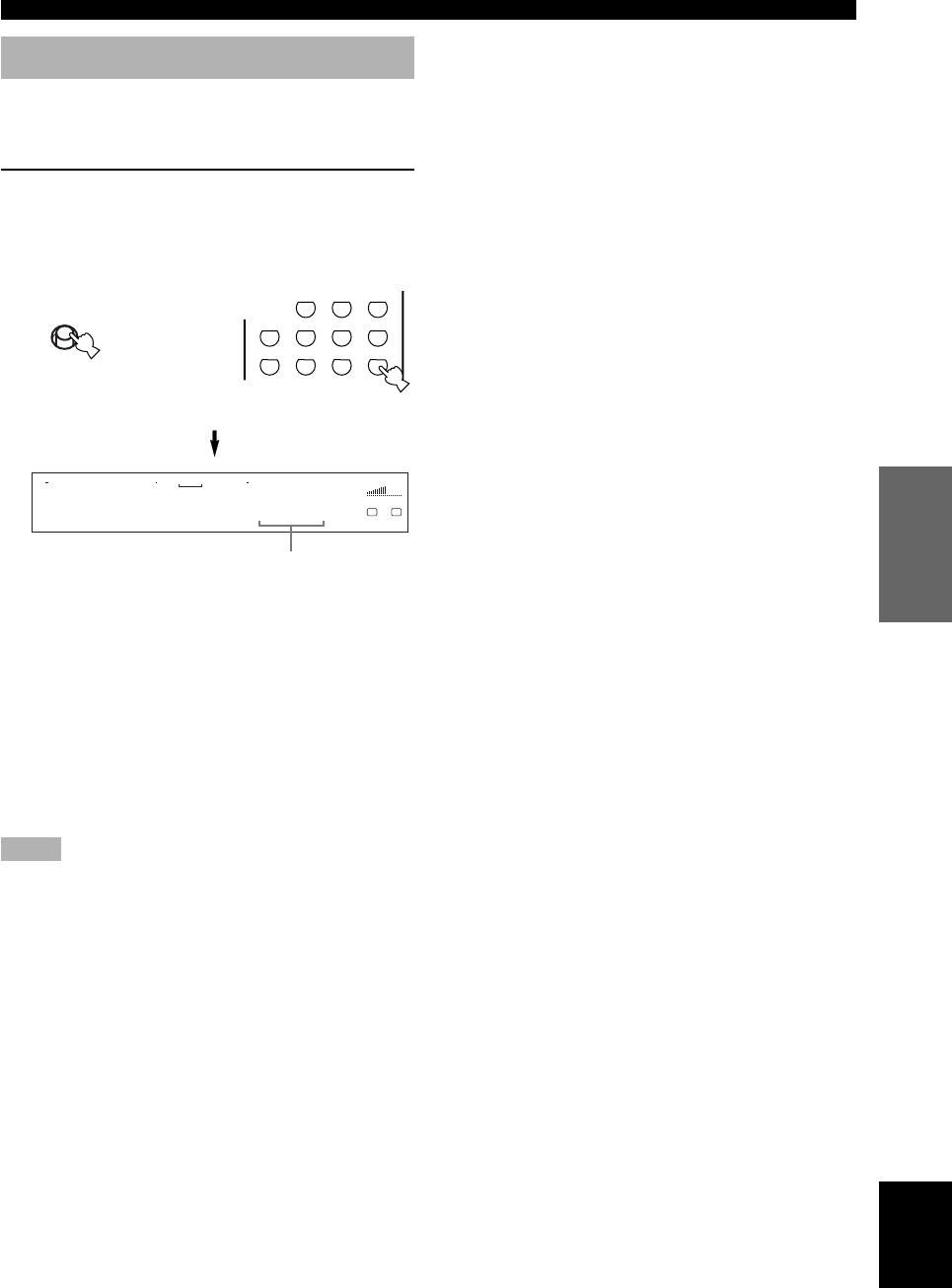
29
English
INTRODUCTION
PREPARATION
BASIC
OPERATION
ADVANCED
OPERATION
ADDITIONAL
INFORMATION
APPENDIX
BASIC PLAYBACK
Input Modes and Indications
This unit comes with various input jacks. You can set the
priority of the input signal among different types of input
signals.
Press MODE (the input selector button that
you have pressed to select the input source
on the remote control) repeatedly until the
desired input mode is shown on the front
panel display and on the video monitor.
AUTO: In this mode, the input signal is
automatically selected in the following
order:
1) Digital signal
2) Analog signal
DTS: In this mode, only the digital input signal
encoded with DTS is selected even if
another signal is input at the same time.
ANALOG: In this mode, only the analog input signal is
selected even if a digital signal is input at
the same time.
Notes
• If digital signals are input from both the COAXIAL and
OPTICAL jacks, the digital signal from the COAXIAL jack
has precedence over the OPTICAL jack.
• In playing the disc encoded with Dolby Digital or DTS on
some LD or DVD players, the sound output delays for a
moment when playback resumes after a search because the
digital signal is selected again.
• When playing the LD source that has not been digitally
recorded, the sound may not be output for some LD players. In
this case, set the input mode to ANALOG.
y
• When AUTO is selected, this unit automatically determines the
type of signal. If this unit detects a Dolby Digital or DTS
signal, the decoder automatically switches to the appropriate
setting.
• When you turn on the power of this unit, the input mode is set
according to “8 INPUT MODE” on the SET MENU (see page
62 for details).
MODE
LR
VCR DVD TUNER CD
PHONO
CD RVAUX 1
SP
VCR2/DVR
CBL
/
SAT
MD
/
TAPE
TV
/
LD
VOLUME
D
A
DVD AUTO
A
PHONO
V
-
AUX
D
-
TV/LD VCR2/DVRVCR 1 DVD
CBL/SAT MD/TAPE CD-R
TUNER CD
Remote controlFront panel
or
Input mode
■ Notes on the digital signal
The digital input jacks of this unit can handle up to a
96 kHz sampling digital signal. Both OPTICAL and
COAXIAL input jacks can be used to input the digital
signal up to 48 kHz. However when inputting a higher
digital signal than 48 kHz, be aware of the following
points.
• DSP programs cannot be selected. Sound will be output as
normal 2-channel stereo sound from only the left and right
main speakers.
• Use the coaxial input (COAXIAL IN) jack to input over
96 kHz digital signals. The signals may not be correctly played
back if the optical input (OPTICAL IN) jack is used.
• Level adjustment for effect speakers other than a subwoofer is
not possible.
■ Notes on playing DTS-CD/LDs
• If the digital output data of the player has been
processed in any way, you may not be able to perform
DTS decoding even if you make a digital connection
between this unit and the player.
• If you play a source encoded with a DTS signal and
set the input mode to ANALOG, this unit reproduces
the noise of an unprocessed DTS signal. When you
want to play a DTS source, be sure to connect the
source to a digital input jack and set the input mode to
AUTO or DTS.
• If you switch the input mode to ANALOG while
playing a source encoded with a DTS signal, this unit
reproduces no sound.
• If you play a source encoded with a DTS signal with
the input mode set to AUTO;
–This unit automatically switches to the DTS-
decoding mode (The “t” indicator lights up.)
after having detected the DTS signal. When playback
of the DTS source is completed, the “t” indicator
may flash. While this indicator is flashing, only DTS
source can be played. If you want to play a normal
PCM source soon, set the input mode back to AUTO.
–The “t” indicator may flash when a search or
skip operation is performed while the DTS source is
playing back with the input mode set to AUTO. If
this status continues for longer than 30 seconds, this
unit will automatically switch from “DTS-decoding”
mode to PCM digital signal input mode. The “t”
indicator will turn off.
0105HTR5590_27-33_EN(U) 02.8.5, 4:30 PM29


















